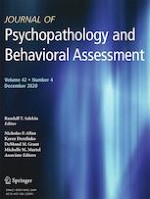08-08-2020
Model Fit and Convergent and Discriminant Validity of the Psychopathic Personality Inventory-Short Form: a Comparison of Competing Models
Gepubliceerd in: Journal of Psychopathology and Behavioral Assessment | Uitgave 4/2020
Log in om toegang te krijgenAbstract
The present study examined the construct validity of the PPI-SF, testing both its factor structure and the convergent and discriminant validity. Using a community sample of 1257 community members (869 females, 378 males), we tested whether a three-factor or an eight-factor model best fit the data and tested the links between the resultant factor structures and external correlates. Confirmatory factor analysis (CFA) and exploratory factor analysis (EFA) findings revealed an eight-factor model best fit the data, followed by a three-factor model. Next, comparisons were made regarding the convergent and discriminant validity of the competing three- and eight-factor models. Findings showed that both models had meaningful relations with external variables, such as neuroticism, stress tolerance, and lack of empathy. The three-factor model revealed psychometric problems with the fearless dominance (FD) scale which did not exhibit good convergent discriminant validity. However, the three-factor model may consolidate the adaptive healthy traits. The eight-factor model had some additional problems with the fearlessness factor, however, showing that adaptive traits were spread across several PPI-SF factors. These findings underscore not only the importance of examining factor structure fit statistics, but also convergent and discriminant validity. The current findings suggest that both the three-and eight-factor models are viable ways to interpret the PPI-SF. However, the factors vary in whether they index adaptive or maladaptive traits. We offer some recommendations for clinicians regarding how to interpret FD and fearlessness and other trait domains within the broader psychopathy framework.
